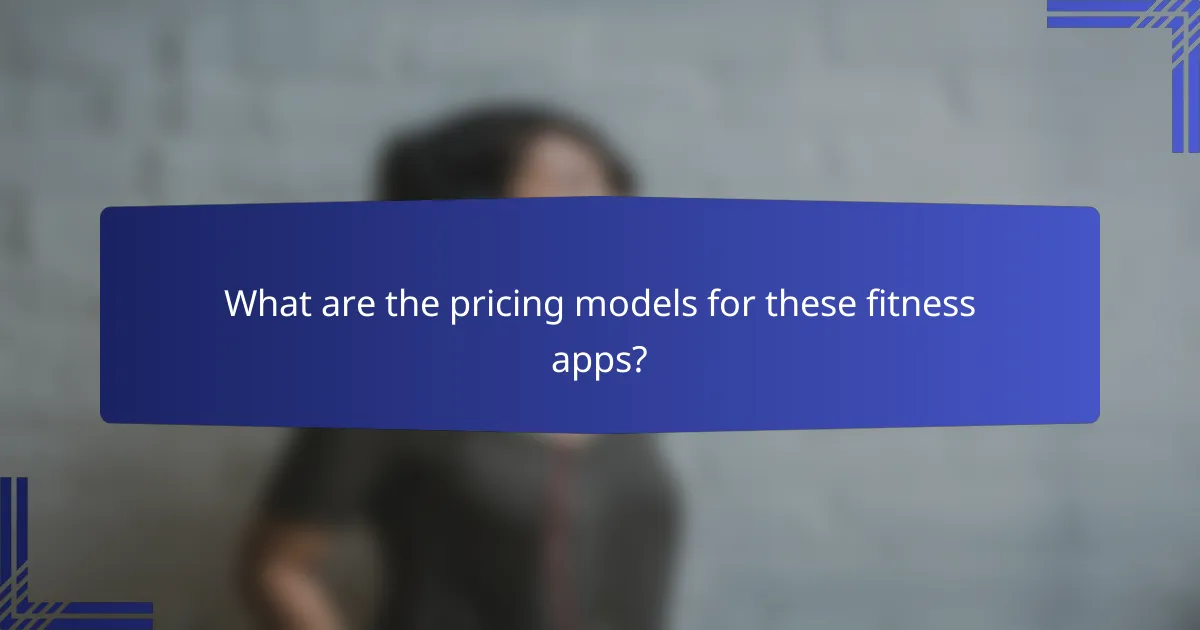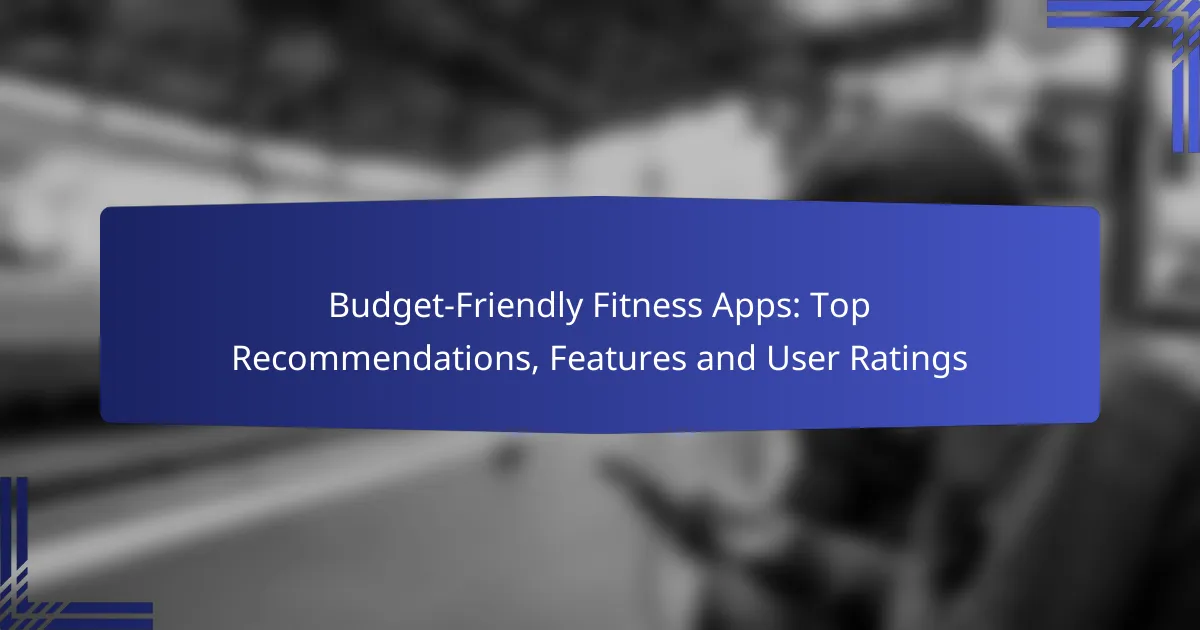Discovering budget-friendly fitness apps can greatly enhance your workout experience without straining your wallet. These apps offer a range of features tailored to different fitness levels and goals, ensuring accessibility for everyone. By considering user ratings and essential functionalities like workout tracking and nutrition logging, you can find the perfect app to support your fitness journey.

Which budget-friendly fitness apps are recommended?
Several budget-friendly fitness apps stand out for their features, user ratings, and overall effectiveness. These apps cater to various fitness levels and goals, making them accessible and practical for users looking to stay fit without breaking the bank.
MyFitnessPal
MyFitnessPal is a popular app focused on nutrition and calorie tracking. Users can log their meals and exercises, helping them maintain a balanced diet while reaching their fitness goals. The app offers a large food database, making it easy to track intake accurately.
Consider using MyFitnessPal if you want to monitor your diet closely. The free version provides essential features, while a premium subscription unlocks advanced tools like meal planning and detailed nutrient analysis.
Fitbit App
The Fitbit App pairs with Fitbit devices but can also be used independently to track physical activity and health metrics. Users can log workouts, monitor heart rate, and set fitness goals. The app’s community features allow for social interaction and motivation.
If you’re looking for a comprehensive fitness tracker, the Fitbit App is a solid choice. While the app is free, some features require a Fitbit device, and premium options offer personalized coaching and insights.
Nike Training Club
Nike Training Club provides a variety of workout routines designed by professional trainers. The app offers both free and premium content, including strength, endurance, and mobility workouts. Users can filter workouts by duration, intensity, and equipment needed.
This app is ideal for those seeking structured workout plans. The free version includes a wide range of workouts, while the premium subscription offers exclusive content and personalized training plans.
Strava
Strava is particularly popular among runners and cyclists, allowing users to track their activities and connect with a community of athletes. The app provides detailed performance metrics and allows users to join challenges and compete with friends.
Strava is great for those who enjoy social fitness and competition. The basic version is free, while the premium subscription includes advanced analytics and personalized coaching features.
JEFIT
JEFIT is a workout planner and tracker that caters to weightlifting and bodybuilding enthusiasts. Users can create custom workout routines and track their progress over time. The app includes a library of exercises with instructional videos.
For those focused on strength training, JEFIT offers a robust platform. The free version provides essential features, while the premium option unlocks advanced tracking and workout analytics.

What features should I look for in fitness apps?
When choosing a fitness app, prioritize features that enhance your workout experience and help you achieve your goals. Key aspects to consider include workout tracking, nutrition logging, community support, and personalized plans, which can significantly influence your progress and motivation.
Workout tracking
Workout tracking is essential for monitoring your exercise routines and progress over time. Look for apps that allow you to log various activities, set goals, and track metrics like duration, intensity, and calories burned. Many apps offer integration with wearable devices, which can provide more accurate data and insights.
Consider apps that provide visual progress reports, such as graphs or charts, to help you see improvements. This feature can motivate you to stay consistent and push your limits.
Nutrition logging
Nutrition logging helps you maintain a balanced diet by tracking your food intake and nutritional values. Choose apps that have extensive food databases, barcode scanning, and the ability to log meals easily. This functionality can assist you in understanding your caloric intake and macronutrient distribution.
Some apps also offer meal planning features, allowing you to create grocery lists based on your dietary goals. This can simplify your shopping and meal prep, making it easier to stick to your nutrition plan.
Community support
Community support can enhance your fitness journey by providing motivation and accountability. Look for apps that include forums, social sharing options, or challenges that allow you to connect with other users. Engaging with a community can help you stay committed and inspired.
Consider features like leaderboards or group challenges that foster a sense of competition and camaraderie. These elements can make your fitness journey more enjoyable and less isolating.
Personalized plans
Personalized plans tailor workouts and nutrition advice to your individual needs and goals. Seek apps that offer assessments to determine your fitness level and preferences, which can lead to customized workout routines. This personalization can enhance effectiveness and keep you engaged.
Some apps may also adapt your plans based on your progress, ensuring that you continually challenge yourself. This dynamic approach can prevent plateaus and maintain your interest over time.

How do user ratings compare for these apps?
User ratings for budget-friendly fitness apps vary significantly, reflecting user experiences and satisfaction levels. Generally, these ratings can help potential users gauge the effectiveness and usability of each app before making a choice.
MyFitnessPal ratings
MyFitnessPal typically receives high ratings, often in the 4 to 5-star range on major app stores. Users appreciate its extensive food database and user-friendly interface, which makes tracking nutrition straightforward.
However, some users report that the app can be overwhelming due to its numerous features. It’s advisable to focus on the core functionalities that suit your fitness goals to avoid feeling lost.
Fitbit App ratings
The Fitbit App generally holds ratings between 4 and 4.5 stars, praised for its seamless integration with Fitbit devices. Users find it effective for tracking workouts, sleep patterns, and overall health metrics.
While the app is beneficial for Fitbit users, those without the device may find it less useful. Consider whether you plan to invest in a Fitbit device before committing to the app.
Nike Training Club ratings
Nike Training Club often garners ratings around 4.5 stars, with users highlighting its variety of workouts and guided training sessions. The app offers both free and premium content, catering to different fitness levels.
One common piece of advice is to explore the free workouts first to determine if the premium features are worth the investment. This helps users avoid unnecessary expenses if they find the free content sufficient.
Strava ratings
Strava usually receives ratings in the 4 to 4.5-star range, particularly favored by cyclists and runners. Users appreciate its social features, allowing them to connect with friends and share progress.
However, some users mention that the app’s focus on social competition can be intimidating. It’s beneficial to use Strava at your own pace and focus on personal goals rather than comparisons with others.

What are the pricing models for these fitness apps?
Fitness apps typically offer a variety of pricing models, including free, premium, and subscription-based options. Understanding these models can help users choose the best app that fits their budget and fitness goals.
Free vs. premium options
Many fitness apps provide free versions with basic features, allowing users to access workouts, tracking tools, and community support. However, premium options often unlock advanced features such as personalized training plans, nutrition tracking, and ad-free experiences.
When choosing between free and premium, consider your fitness needs. If you require more specialized guidance or features, investing in a premium subscription might be worthwhile.
Subscription costs
Subscription costs for fitness apps can vary widely, typically ranging from around $5 to $30 per month. Some apps offer annual plans that can reduce the overall cost, often providing a discount compared to monthly payments.
Before subscribing, check if the app offers a free trial period. This allows you to evaluate the app’s features and usability without financial commitment.
In-app purchases
In-app purchases are additional features or content that can be bought within the app, such as specialized workout programs, meal plans, or virtual coaching sessions. These purchases can enhance the user experience but may add up if not monitored.
To avoid unexpected costs, review the app’s pricing structure before making purchases. Consider whether the added features align with your fitness goals and if they justify the expense.

How do these apps support fitness goals?
Budget-friendly fitness apps support fitness goals by providing accessible tools for tracking workouts, nutrition, and progress. They often include features like workout plans, community support, and personalized coaching to help users stay motivated and accountable.
Top Recommendations
Some of the most recommended budget-friendly fitness apps include MyFitnessPal, Fitbit, and Nike Training Club. MyFitnessPal excels in calorie tracking and meal planning, while Fitbit offers comprehensive activity tracking and insights. Nike Training Club provides a variety of workout routines tailored to different fitness levels.
Features to Consider
When choosing a fitness app, consider features such as workout variety, user interface, and integration with wearable devices. Look for apps that offer personalized workout plans, progress tracking, and community engagement. Some apps may also include nutrition tracking, which can be beneficial for overall fitness goals.
User Ratings and Feedback
User ratings can provide valuable insights into the effectiveness of fitness apps. Apps like MyFitnessPal often receive high ratings for their extensive food database and user-friendly interface. However, it’s essential to read reviews to understand potential drawbacks, such as ads in free versions or limited features without a subscription.
